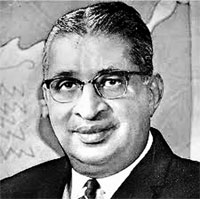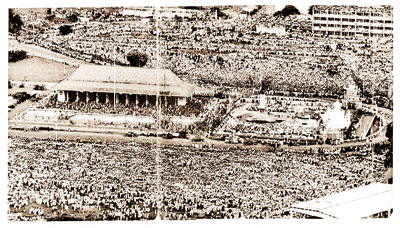Sunday Times 2
The recovery of the UNP
View(s):April 12 marks the 48th Death Anniversary of Dudley Senanayake. We publish an excerpt from the book ‘Sri Lanka: Come Wind, Come Weather’ by K M de Silva.

Dudley Senanayake
After the decisive defeat the UNP under Sir John Kotelawala had suffered in April 1956, few people in Sri Lanka’s political elite expected the UNP to make an early recovery. Quite apart from the defeat being a colossal one, the party itself was without a leader. The defeated Prime Minister opted out of politics and within a short time began spending half the year in England where he established himself in a farm, Brogues Wood in Kent. Dudley Senanayake had moved out of the UNP. J R Jayewardene had lost his seat. Nevertheless he (J R Jayewardene) remained a member of the UNP and when the first opportunity occurred for fashioning the recovery of the UNP he decided to seize it. This was with regard to elections to the Colombo Municipal Council, which were due un December 1956. The man who actually initiated the move to contest seats in the Colombo Municipal Council was V A Sugathadasa who convinced J R Jayewardene that the UNP should organize a systematic campaign there. Once Jayewardene agreed to lead the way, the UNP campaign began and led by him, it resulted in a handsome victory, which surprised the Bandaranaike government and its component parties especially from the parties of the Left.

The crowds at the funeral
The survival of the UNP after its defeat in April 1956 owed more to J R Jayewardene than to any individual, or indeed group of persons within the party including V A Sugathadasa. He restored its morale by demonstrating its continued viability at the elections to the Colombo Municipal Council in December 1956 which the UNP won handsomely; he revamped its organisation and sought to give it a new image, one which was more attuned to the changed circumstances of the day. The success he achieved, as demonstrated by its imporved position at the three general elections of 1960 compared to its parlous state in 1956, it may have been more substantial if the general elections had come, as they should have, somewhat later. As it was the SLFP came back to power in 1960 under Mrs Bandaranaike for another period of nearly five years. Jayewardene was still the No 2 man in the UNP a position he accepted without demur. He was the master strategist who fashioned the eventual defeat of Mrs Bandaranaike’s government in Parliament by a skilful exploitation of the fears of some prominent, and disgruntled SLFPers, of the consequences of a coalition with the Marxist Left which the then Prime Minister, Mrs Bandaranaike had negotiated in 1964.
Dudley Senanayake returned to the UNP and led the party back to power for a very brief period. But his was a minority government on this occasion (early 1960) and when it was defeated on the debate on the ‘throne’ speech, he called for fresh elections, which took place in July 1960 and in which his party was defeated. Dudley Senanayake now became Leader of the Opposition. When the UNP won the general election of March 1965 he became Prime Minister once more, as the head of a coalition dominated by the UNP. He was Prime Minister, on this occasion for five years.
Dudley Senanayake, like his father, had a passion for traditional agriculture and regarded it as the key to the economic regeneration of the country. The remarkable breakthrough in economic growth that came in the period 1967-70 was the result of the leadership he gave to a Sri Lanka version of the green revolution. In such success as was achieved his personal role in organizing and encouraging the national food drive as crucial. In the end, however, the political advantages anticipated from this very considerable achievement in economic development eluded his government. Nor did he have much greater success in the policies of ethnic and religious reconciliation which he initiated. His failure in these latter stemmed as much from the successful exploitation of the fears of the Sinhalese majority in these matters by opposition political groups as by rumbles of discontent within his own party.
At the general election of 1970 Dudley Senanayake suffered a heavy defeat at the hands of the United Front coalition led by Mrs. Bandaranaike and consisting also of the major traditional Marxist parties of the country. His spirit never really recovered from this defeat. It was much like that the party suffered in 1956. After the defeat in 1970, the leadership of the opposition went by default to J.R. Jayewardene as Dudley Senanayake’s deputy. In the years 1970-72 Dudley Senanayake’s position as leader of the UNP was challenged by the latter, and though Dudley Senanayake eventually prevailed in this, he was compelled to accommodate himself to a virtual duumvirate. But by 1972 the position of the UNP had improved remarkably in the country at large and was at last in a position to mount a serious challenge to the government.
On 13 April 1973 Dudley Senanayake died after a short illness. His death led to unprecedented scenes of spontaneous grief and mourning throughout the country. The cremation of his body on 21 April attracted the largest crowd ever gathered together for any occassion in the island’s history, much larger than those for his father’s cremation in 1952 and for Bandaranaike’s cremation in 1959, unmistable tribute to a much-loved figure.
The political implications of this huge political gathering were lost on the members of Mrs Bandaranaike’s government, in particular the Left-wing parties, the LSSP and the Moscow wing of the CP.


